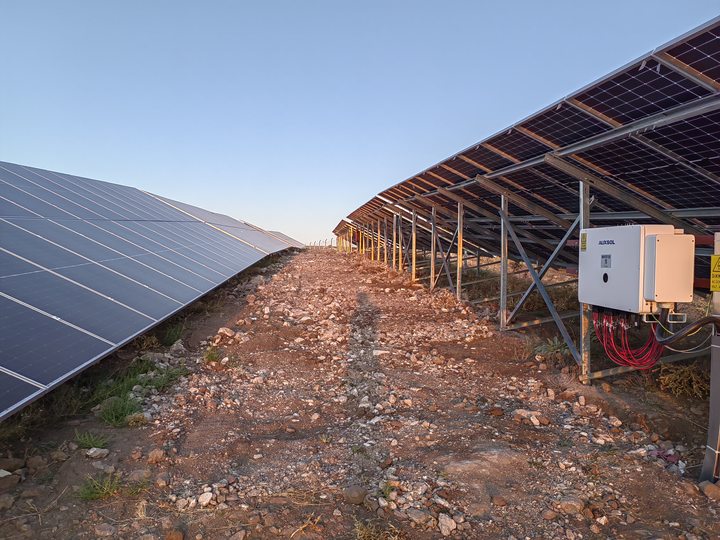If you’re switching to solar power, a grid-tied solar inverter is a game-changer—but what exactly is it, and how does it stack up against off-grid inverters? In this guide, we break down everything you need to know about grid-tied solar inverters, why they’re a must for solar panels, and highlight reliable models like AUXSOL’s ASN series to simplify your choice.
What Is a Grid-Tied Solar Inverter?
A grid-tied solar inverter is a critical component of grid-tied solar systems (linked to your local utility grid). Its core job? Convert the direct current (DC) electricity generated by solar panels into alternating current (AC).
But it does more than just convert power. To safely feed excess energy into the grid, it synchronizes with the grid’s voltage and frequency—a must to meet utility standards. When your solar panels produce more power than you need, the inverter sends that surplus to the grid. Many utility companies reward this via net metering, crediting your bill, or even paying you for the extra energy.
Compared to off-grid setups, grid-tied inverters don’t require batteries (cutting costs) and work seamlessly with the grid to balance supply and demand. For example, on cloudy days when solar output drops, the inverter automatically draws extra power from the grid to keep your home running.
What Is the Difference Between a Grid-Tie Inverter and an Off-grid Inverter?
Grid-tied inverters and off-grid inverters serve different purposes—here’s how they compare:
| Feature |
Grid-Tied Solar Inverter |
Off-Grid Inverter |
| Grid Connection |
Tied to the utility grid; works with it |
No grid connection; operates independently |
| Power Conversion |
Converts DC (solar) to AC for home/grid use |
Converts DC (from batteries) to AC for appliances |
| Synchronization |
Syncs voltage/frequency with the grid |
Cannot sync with the grid |
| Energy Storage |
No batteries needed (excess goes to the grid) |
Relies on batteries to store and supply power |
| Functionality |
Switches between solar and grid power automatically |
Only supplies power from batteries; no grid backup |
| Cost & Maintenance |
Lower upfront cost (no batteries); less maintenance |
Higher cost (batteries + upkeep); more complex |
For example, if your solar panels generate 5kW on a sunny day but you only use 3kW, a grid-tied inverter sends the extra 2kW to the grid. An off-grid inverter, by contrast, would store that 2kW in batteries or waste it if batteries are full.
Why Grid-Tied Inverter Is Ideal For Solar Panels?
Grid-tied inverters are tailor-made for solar panels—here’s why they’re the top choice:
-
Maximize Energy Use & Savings: They let you use solar power first, then tap the grid only when needed. Excess energy goes to the grid for credits, slashing your electricity bills.
-
Cost-Effective: No battery requirement means lower upfront costs and less maintenance (batteries degrade over time and need replacement).
-
Seamless Power Supply: They automatically switch between solar and grid power—no manual adjustments. On sunny days, you’ll rely less on the grid; on cloudy days, you won’t notice a gap.
-
Eco-Friendly: By feeding surplus solar energy to the grid, you reduce reliance on fossil fuel-based power, cutting your carbon footprint.
Top-tier models like AUXSOL’s grid-tied inverters enhance these benefits further. For instance:
-
AUXSOL ASN-(3.6-6)SL-PLUS: A single-phase model with an 80V low start-up voltage (so it begins generating power earlier in the day) and IP66 protection (dustproof, waterproof—ideal for indoor/outdoor use). It supports 1.5x DC/AC oversizing, letting you pair it with more panels for extra output.
-
AUXSOL ASN-(7-10)SL: Another single-phase option with ultra-wide grid voltage design. It works even if the grid is unstable and has a silent design (<35dB)—perfect for residential areas. No power derating at 45°C means it performs reliably in hot weather.
-
AUXSOL ASN-(5-25)TL: A three-phase inverter for homes or C&I setups. It has a 180V start-up voltage, pure film capacitors (25-year lifespan), and IP66 protection. With up to 32kW max input power, it handles high solar output with ease.
RFQ: Common Questions About Grid-Tied Inverters
Got questions? We’ve got answers to the most frequent ones:
-
Are Grid-Tied Inverters Noisy?
Most modern grid-tied inverters are designed for quiet operation—especially residential models. For example, AUXSOL’s ASN-(7-10)SL has a silent design (<35dB), which is quieter than a typical conversation.
-
Are Grid-Tied Inverters Safe?
Yes, grid-tied inverters have built-in safety features to protect you, your home, and utility workers:
-
Anti-islanding protection: Shuts down the inverter if the grid goes out, preventing it from feeding power into the grid (avoids electrocuting workers repairing lines).
-
Overvoltage/overcurrent protection: Stops damage if power surges occur.
-
IP ratings: Models like AUXSOL’s ASN series have IP66 protection, shielding against dust, rain, and harsh weather.
Final Thoughts
Grid-tied solar inverters are the backbone of affordable, efficient solar systems. They save you money, reduce your carbon footprint, and work seamlessly with the grid. For reliable performance, consider AUXSOL’s ASN series.

